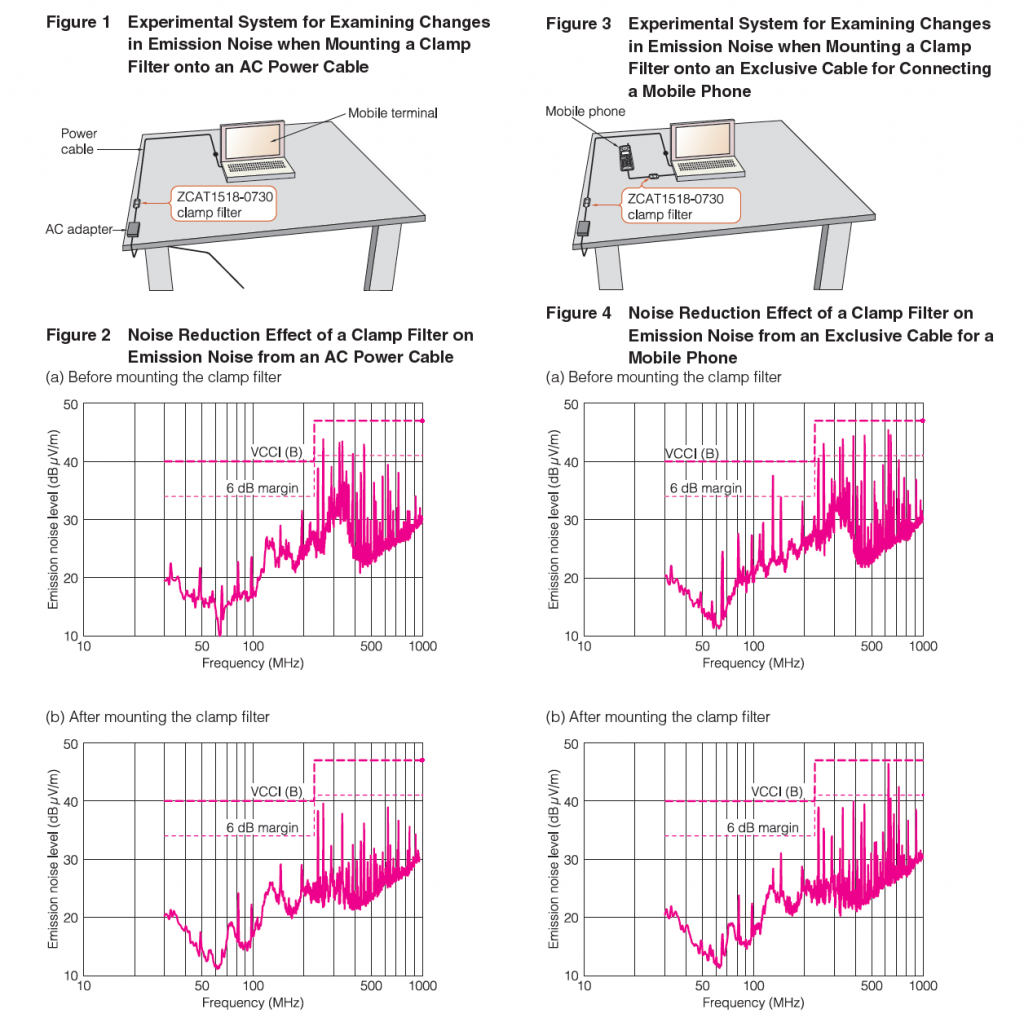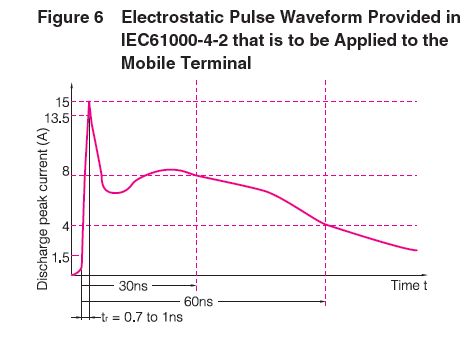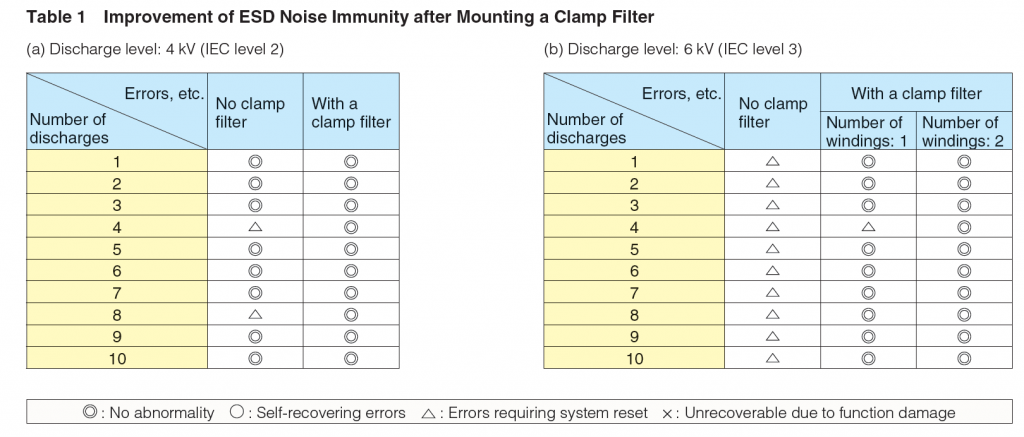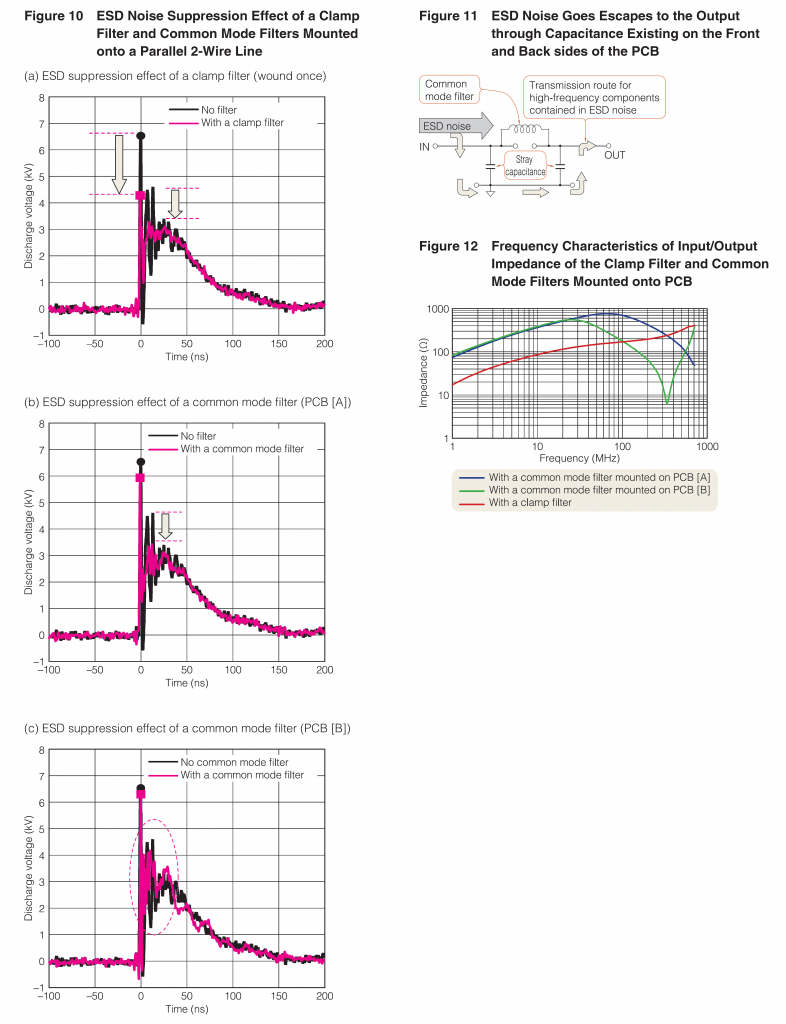
Clamp Filters that Suppress Emission Noise Provide Immunity Against Surge Noise
 Reduce Emission Noise from Cables
Reduce Emission Noise from Cables
A Type of Common Mode Filter
When many people think of common mode filters (here after referred to as CMFs), they might imagine a component that is mounted onto a PCB. However, a clamp filter is also a type of common mode filter. It only eliminates common mode noise flowing in interface cables, without attenuating differential mode currents. Compared to a CMF in which conductive wires are wound, a clamp filter causes small, almost negligible, stray capacitance or electromagnetic coupling; therefore, differential mode impedance is kept low over a wide range of frequencies, and signals are hardly affected at all. Although clamp filters have relatively low common mode impedance, they exhibit stable impedance characteristics, since there are no effects from distributed stray capacitance caused by wound wire and, therefore, self-resonance does not occur even up to approximately 1 GHz.
Adjusting the Amount of Winding
When winding a cable to a clamp filter on two or three times, effective impedance will be enhanced, leading to higher attenuation characteristics. However, as the amount of winding increases, stray capacitance or electromagnetic coupling becomes larger. The most effective amount can be found through trying out various amounts of winding.
1.Confirming the Effect of Reducing Emission Noise through Experiments
In addition to AC power adapters, various peripheral devices, such as digital still cameras or mobile phones, are connected to mobile terminals represented by mobile PCs through various interface cables. In this section, clamp filters will be mounted to these interface cables and their noise reduction effects will be tested.
Connecting an AC Power
The spectrum of emission noise from a mobile phone before and after mounting a ZCAT1518-0730 clamp filter to the power cable is shown in Figure 1. In this test, a cable was wound twice around the filter. The measurement results are shown in Figure 2. Before mounting, noise was emitted at frequencies from 250 to 600 MHz, barely satisfying the VCCI class B standard. After mounting the clamp filter, noise was relatively reduced by approximately 5 to 10 dB.
Connecting a MobileAs is shown in Figure 3, a mobile terminal was connected to a mobile phone with an exclusive cable, with a ZCAT1518-0730 clamp filter connected to the power cable.
The measurement results are shown in Figure 4. Before mounting the clamp filter, noise was emitted at a broad frequency band from 100 to 600 MHz. As in the case of the previous test, after winding the exclusive cable twice around the clamp filter, noise was relatively reduced by 5 to 10 dB. Noise at frequencies of 600 MHz or higher, which did not change after mounting the clamp filter, seemed to be emitted from sources other than the cable.

2.Clamp Filters Improve Immunity to Electrostatic
When a clamp filter is mounted, not only is emission noise reduced, but errors due to external noise, such as surges or static electricity are also reduced. An ESD (electrostatic discharge) test based on the international standard IEC61000-4 for immunity testing was conducted to examine the frequency or level change of errors before and after mounting the clamp filter.ESD is a phenomenon that occurs when the electric charge accumulated on a body due to causes such as friction with clothes is discharged when the body touches the housing of an electronic device, etc. Immunity means resistance against external noise.
Testing Method
As is shown in Figure 5, a mobile terminal under operating conditions and a printer were connected. Static electricity was discharged onto the mobile terminal, and the conditions of errors were recorded. ESD was applied to the connector plug shell on the mobile terminal side of the connector cable 10 times with one second intervals.

The discharge method was pursuant to the contact discharge method provided in the international immunity standard IEC61000-4-2. The electrostatic pulse waveform for testing specified in IEC61000-4-2 is shown in Figure 6. The levels of discharges were 2 kV, 4 kV and 6 kV.
 Test Results
Test ResultsThe test results are shown in Table 1.
When no clamp filter was mounted, errors such as stopping of printer operations were observed even at 4 kV. At 6 kV, the printer stopped completely.
When one ZCAT2035-0930A clamp filter (wound once) was mounted, there were no problems in operations at 4 kV, and few errors occurred even at 6 kV. When winding was performed twice, no errors were observed.

The ESD waveforms before and after mounting the clamp filter are shown in Figure 7. Winding was performed twice. ESD was significantly attenuated by the clamp filter. The waveforms were observed at a position near the clamp filter on the cable between the clamp filter and the printer.

3.ESD Noise Suppression Effects in a Parallel Two-Wire Line
The ESD noise suppression effect of a clamp filter when it is mounted onto a parallel two-wire line was evaluated by an experiment. A comparison was made with the previously-described onboard type CMF.Measurement System
The measurement system is shown in Figure 8. Two parallel wires with a length of 1 m were placed at a height of 0.1 m from the ground plane. 6 kV of static electricity generated by an electrostatic generator was applied by an ESD gun to the input side of the line. The ESD and the line were brought into contact with each other. The waveform of static electricity generated by the electrostatic generator was a high speed, spike voltage with a rise time of between 0.7 to 1 ns.

A ZCAT2035-0930A clamp filter (hereinafter referred to as ZCAT) and a onboard type CMF ZJYS51R5-2P (hereinafter referred to as ZJYS) were inserted into the halfway point of the parallel wires, and changes in the ESD waveform were observed on the output side. As is shown in Figure 9, two types of PCBs were prepared onto which ZJYSs were mounted; one was a PCB with a thickness of 1 mm, having no copper foil pattern on the back side (PCB), and the other was a PCB with a thickness of 0.3 mm, with the entire backside being a ground plane (PCB).

High Surge Noise Suppression Effect
The waveforms observed at the output terminal are shown in Figure 10.
From Figure 10 (a), it is clear that approximately 40% of noise was attenuated after the clamp filter was mounted. Ringing immediately following the voltage rise was also attenuated.
In Figs. 10 (b) and (c), the waveforms in the cases where ZJYSs were mounted show that ringing was attenuated to the same extent as ZCATs, but that the spike voltage at the rise time was not attenuated. In particular, there was almost no attenuation in the PCB [A]. In order to examine the cause, the input/output capacitances of the PCB [A] and PCB [B] were measured using a capacitance meter. As a result, the capacitance of the PCB [A] was approximately 0.1 pF and the capacitance of PCB [B] was 7.3 pF. It seems that in the PCB [B], large stray capacitance existed between the copper foil on the component surfaces and that electrostatic noise escaped to the output side through this capacitance, as is shown in Figure 11. As a reference, the impedance frequency characteristics of the clamp filter, the PCB [A] and PCB [B], which were used for the experiments, are shown in Figure 12.
From these experimental results, it is clear that clamp filters exhibit higher surge voltage suppression effects than onboard type CMFs. This is because their ferrite cores do not easily become saturated even when high surge voltage is applied, due to their large physical capacities. Since they are not mounted onto PCB boards, it is not necessary to take into consideration capacitance coupling between inputs and outputs.

Various Product
Lastly, the product selection chart for TDK clamp filters is shown in Table 2. TDK provides various series of products covering a wide range of applications, from application in general-purpose cables to application in flat cables.
Table 2 Selection Chart by Cable



